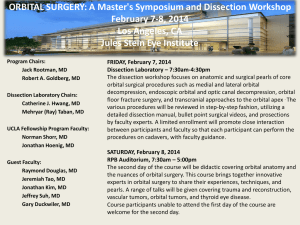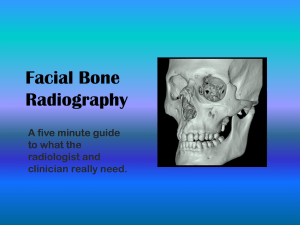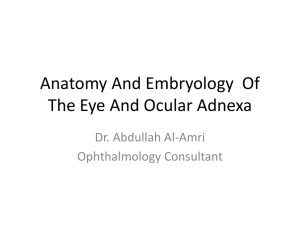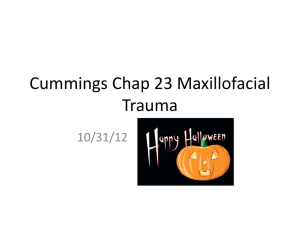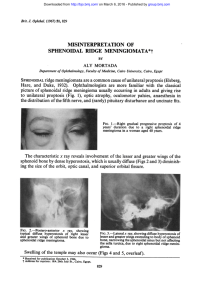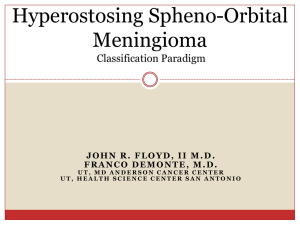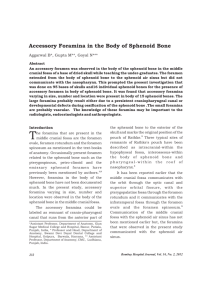Canal: (pipe or channel) Optic canal contains Optic nerve
advertisement
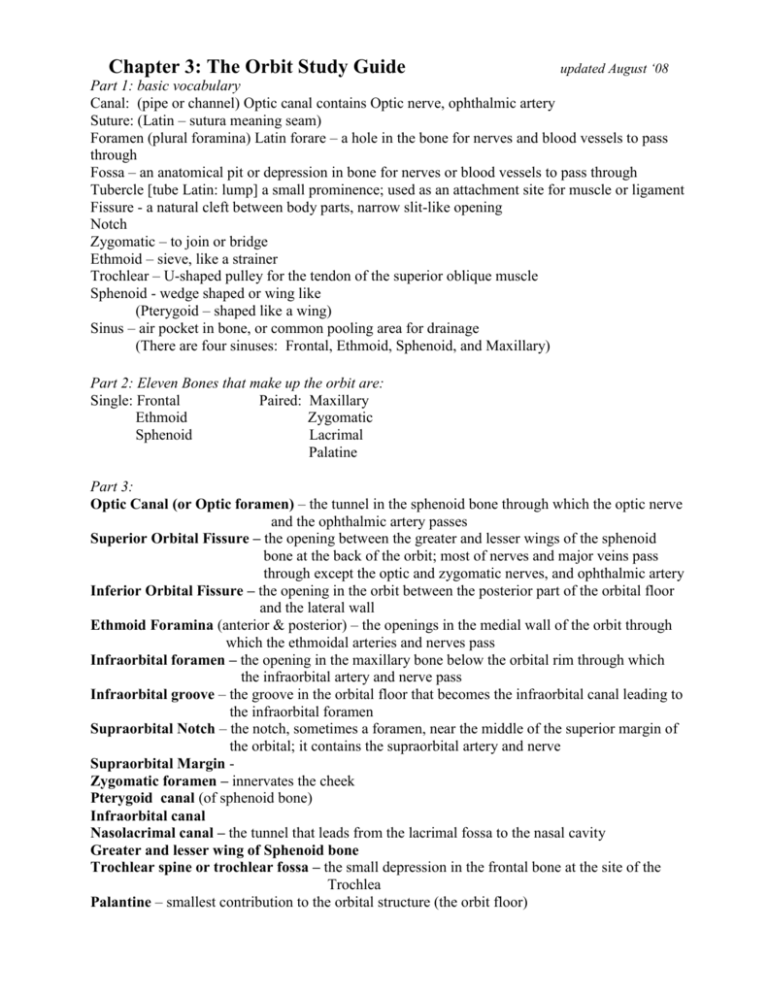
Chapter 3: The Orbit Study Guide updated August ‘08 Part 1: basic vocabulary Canal: (pipe or channel) Optic canal contains Optic nerve, ophthalmic artery Suture: (Latin – sutura meaning seam) Foramen (plural foramina) Latin forare – a hole in the bone for nerves and blood vessels to pass through Fossa – an anatomical pit or depression in bone for nerves or blood vessels to pass through Tubercle [tube Latin: lump] a small prominence; used as an attachment site for muscle or ligament Fissure - a natural cleft between body parts, narrow slit-like opening Notch Zygomatic – to join or bridge Ethmoid – sieve, like a strainer Trochlear – U-shaped pulley for the tendon of the superior oblique muscle Sphenoid - wedge shaped or wing like (Pterygoid – shaped like a wing) Sinus – air pocket in bone, or common pooling area for drainage (There are four sinuses: Frontal, Ethmoid, Sphenoid, and Maxillary) Part 2: Eleven Bones that make up the orbit are: Single: Frontal Paired: Maxillary Ethmoid Zygomatic Sphenoid Lacrimal Palatine Part 3: Optic Canal (or Optic foramen) – the tunnel in the sphenoid bone through which the optic nerve and the ophthalmic artery passes Superior Orbital Fissure – the opening between the greater and lesser wings of the sphenoid bone at the back of the orbit; most of nerves and major veins pass through except the optic and zygomatic nerves, and ophthalmic artery Inferior Orbital Fissure – the opening in the orbit between the posterior part of the orbital floor and the lateral wall Ethmoid Foramina (anterior & posterior) – the openings in the medial wall of the orbit through which the ethmoidal arteries and nerves pass Infraorbital foramen – the opening in the maxillary bone below the orbital rim through which the infraorbital artery and nerve pass Infraorbital groove – the groove in the orbital floor that becomes the infraorbital canal leading to the infraorbital foramen Supraorbital Notch – the notch, sometimes a foramen, near the middle of the superior margin of the orbital; it contains the supraorbital artery and nerve Supraorbital Margin Zygomatic foramen – innervates the cheek Pterygoid canal (of sphenoid bone) Infraorbital canal Nasolacrimal canal – the tunnel that leads from the lacrimal fossa to the nasal cavity Greater and lesser wing of Sphenoid bone Trochlear spine or trochlear fossa – the small depression in the frontal bone at the site of the Trochlea Palantine – smallest contribution to the orbital structure (the orbit floor) Orbital plate of ethmoid bone is in which orbital wall? How about the frontal or maxillary bones? What is a blowout fracture? Where does it occur? A blowout fracture is caused by force trauma to the orbit. Due to the sheer strength of the orbital bones, the force of the trauma is transmitted to the orbital plate of the maxillary wall, where the thin layer of bone is “blown out.” How about a comminution fracture? It is the breakage of one or more of the bones forming the margin (frontal, zygomatic, or maxillary). Part 4: Know and be able to identify bones of the orbit floor, ceiling, lateral and medial walls. What are the sutures that connect them? What are the fossas, fissures and foramina on these walls? Orbit Ceiling Frontal Bits of sphenoid Lacrimal Fossa, trochlear fossa Orbit Floor Maxillary Zygomatic Palantine Inferior orbital groove, inferior orbital fissure, nasolacrimal canal Lateral Wall Zygomatic Sphenoid (greater wing) Lateral Orbital Tubercle (Whitnall’s tubercle) Medial Wall Maxillary (anteriorly) Sphenoid (posteriorly) Ethmoid & lacrimal bones fill the gap between them Nasolacrimal fossa Lacrimal crests (anterior & posterior) Nasolacrimal canal Periosteum – a thin layer of connective tissue that adheres to the surfaces of bones Periobita – the periosteum that lines the orbital bones Tenon’s capsule – a sheet of connective tissue that lines all of the eye out to the limbus and ensheathes the extraocular muscles, it fits like a glove. Whitenall’s ligament – a sling of connective tissue attached to the orbital ceiling through which the levator muscle passes; also called superior transverse ligament Lockwood’s ligament – suspensory ligament Medial and lateral check ligament Septum orbitale (aka orbital septum and palpebral fascia) – the sheet of connective tissue that is attached to the orbital margin and runs into the eyelids Exophthalmos – a condition in which the eye protrudes farther forward from its normal position in the orbit; also called proptosis Enophthalmos - a condition in which the eye is placed farther back in the orbit than normal


